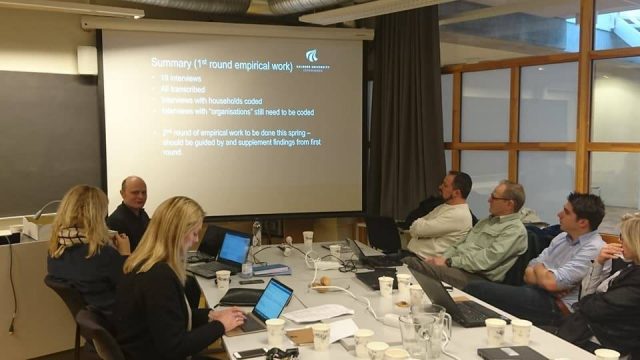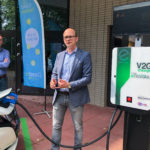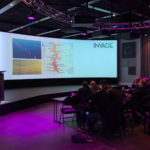How end-users accelerate new technology
By Marianne Ryghaug, Professor in Science and Technology Studies, NTNU 2. October 2017
The success of new technological advancements to a large degree depends on the perceptions and practices of the end-users. That is why INVADE is important.

Through research, development, innovation and implementation, new technologies will become part of the everyday lives and everyday dynamics of end-users.
However, the success of such technological advancements to a large degree depends on the perceptions and practices of end-users and the user engagement with the new technologies and systems.
Accelerating technology
To understand social, cultural and behavioural barriers and opportunities associated with the implemented technologies and to determine best practice implementation and future user involvement strategies, it is necessary to monitor and analyse user practices and behaviour, as we will do in the INVADE project.
Technologies are seldom fixed, stable, or immutable entities, but rather acquire specific meanings and forms of use as they are adapted to household situations, and as they, in turn, influence pre-existing household dynamics.
This is important, as technologies must align with pre-existing routines, practices, identities, and values if they are to be accepted.
Thus, by studying end-users we get insight into changes that take place with respect to human beliefs and actions, as well as with respect to technology and the material environment. This is important, as technologies must align with pre-existing routines, practices, identities, and values if they are to be accepted.
Why Quadruple Helix?
Transition towards a low carbon energy system is going to be comprehensive and demanding. Without a constructive engagement of the public the transition is likely to fail or to be too slow. Therefore, the role the citizens or end-users play in this transition and how they are understood, is very important.

Marianne Ryghaug, Norwegian University of Science and Technology (NTNU)
The traditional understanding of the public has proven to be problematic and out of sync with the developments in our energy systems. Until quite recently it has been common to think of energy users as customers, consumers and as passive actors in the market, or passive recipients of technologies that exist in the outskirt of a rather centralized energy system. While traditional research on energy consumption – if at all – has focused on end-users as barriers, the goal must be to go beyond a simplistic antagonism between user and technology.
This points to a need to include the public and end-users when researching processes of technological innovation, policy development and implementation, since end-users often have been neglected in these processes.
It also points to the need to go beyond the Triple Helix innovation model, that focuses on university-industry-government relations, and instead focus on the Quadruple Helix, which adds as a fourth helix; the culture-based public or civil society.
Society trends and enablers
The gradual shift from centralized and fossil-based production to more decentralized, distributed systems based on renewables, will potentially integrate electricity production into everyday life.
This means that new types of interaction between traditional energy suppliers and customers might be created and their roles may become much more hybridized.
To be able to go from passive users, or mere customers, to participating citizens we must think differently about how to engage users and communities towards new low carbon energy technologies.
One suggestion is to avoid simplistic and reductionist understanding of users, and look more deeply into how to create energy citizenship and to create more inclusive energy dialogues within and between different energy cultures and types of end-users.
Social media
INVADE updates

It is possible to control the speed of charging electric cars on a large scale with algorithms. This can be concluded from the results of a Smart Charging test on 700 public charging stations as part of the Horizon 2020 INVADE project. (4 years ago)

“I found the INVADE pilots incredibly interesting”
During the European Utility Week in Paris in November 2019, the INVADE project presented itself in a unique way in the EU Projects Zone. Using videos and an informative quiz, the INVADE stand was always busy. (4 years ago)

“Solutions like INVADE are necessary”
The Horizon 2020 INVADE project is coming to an end this year. Last week, a conference and a workshop were organized on behalf of the project and parallel to event Smart City Expo World Congress in Barcelona. (4 years ago)

The INVADE project has resulted in five successful pilot stories and professional films have been made from each pilot site. You can watch them all here. (4 years ago)

The work package WP9: Business models and market structures, led by INVADE project partner Lyse has put forward a market structure for platform-based business models inspired by disruptive companies like Amazon and Airbnb. (4 years ago)

In the end of May, the INVADE consortium was gathered in the Netherlands. During the two-day meeting, all five pilot owners presented their progress to the project partners. (4 years ago)

Badenova sells and operates networks, energy storages and smart city infrastructures in a region of nearly 1 million inhabitants and adapts INVADE technology and solutions on site for its customers. (4 years ago)

“We will act on everything we have heard today”
When Norway’s Standing Committee on Energy and the Environment visited Smart Innovation Norway headquarters in Halden on Monday, they were introduced to the company’s unique EU research expertise. (5 years ago)

Energy businesses that manage to incorporate total social impact into their activities, products, services, and communication to customers and employees, will have the best premises for future business growth – and for contributing to a better world. (5 years ago)

What is the added value?
In a few weeks the INVADE integrated platform will be up and running and the pilot owners are both hopeful and excited about what the results will show. (5 years ago)